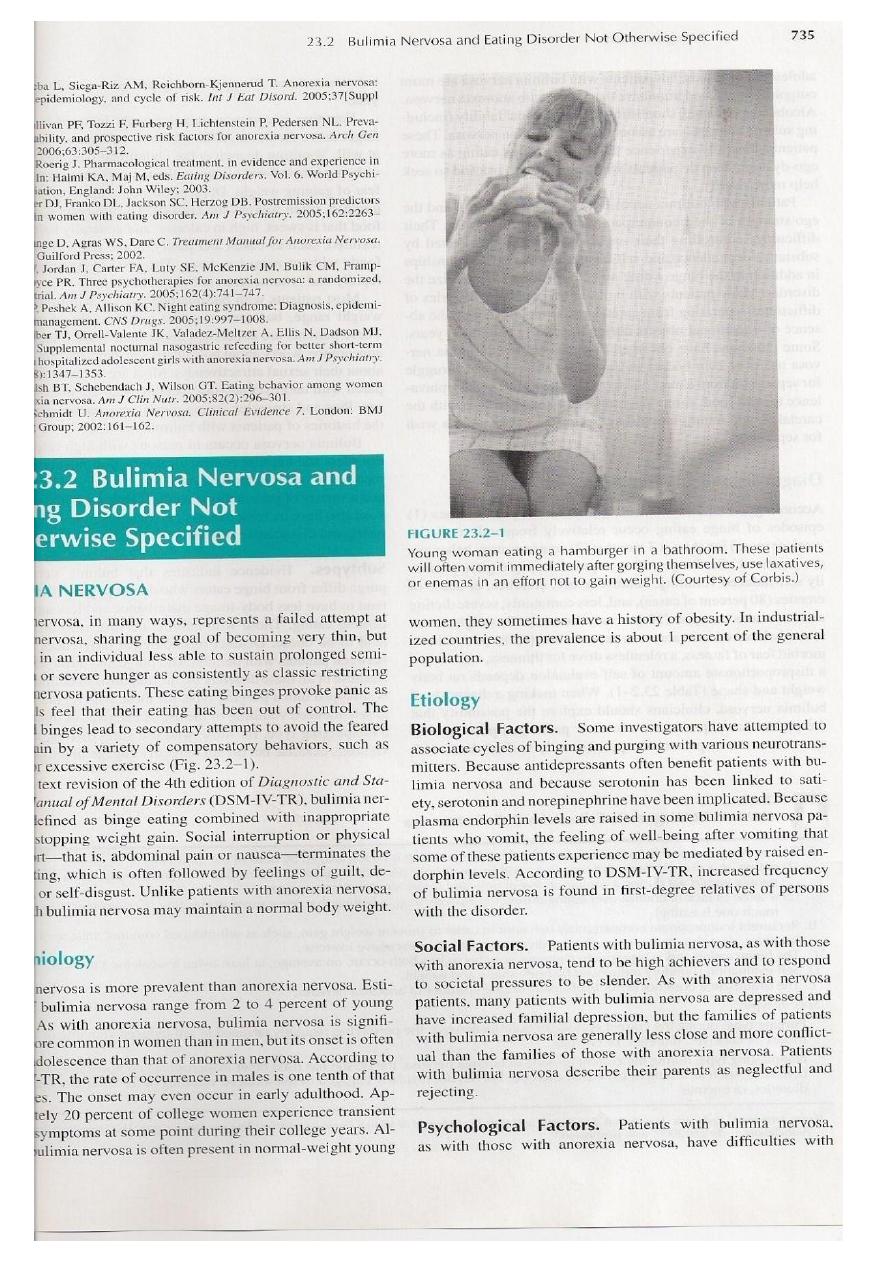
Eating Disorders
د
.
مها
epidemiology; 4% of adolescent and young adults students.
Anorexia nervosa has\been reported more frequently over the past several decades with
increasing reports of the disorder in the prepubertal girls and in boys.
Anorexia nervosa ---concept / etiology
Derived from the Greek word .loss of appetite and Latin word implying nervous in origin ,it’s
a syndrome characterized by 3 features:
1-self induced starvation to a significant degree
2- relentless drive for thinness or morbid features of fatness
3-presence of medical signs and symptoms
Anorexia nervosa 1%
Bulimia nervosa 1-3%
Female : male = 10 :1
Onset : AN-13-20 years old
BN -16.5 –18 years old
Mortality :5-10%
Etiology, Risk factors:
1- multifactorial
2-individual : perfectionism and impulse to control
3-familial ; family effect ,dysfunctional family environment
4-cultural factors ; common in industrialized societies ,effect of media ,others
5-genetic factors

\Risk factors:
1-women who by career choice are expected to be thin
2-family history (mood disorders, eating disorders ,substance abuse )
3-psychiatric illness
4-obesity
5-chronic medical illness like DM
6-history of sexual abuse
AN-Anorexia nervosa-diagnosis:
1-Refusal to maintain above 85% of expected wt for age and height
2-fear of becoming obese even though under weight
3- abnormal perception of body image –wt ,size ,age
4-absence of.> 3 consecutive menstrual cycle
Thinness is not a required features among our Arab culture that explain the rarity of the
AN syndrome.
Types:
1-restricting .no binge eating or purging
2- binge eating /purging during episode of AN
Patients show strange behavior about food like ;hiding food , carry sweets in
pockets ,during eating they throw food ,rearrange pieces ,they deny this unusual
behavior
Obsessive Compulsive behavior ,depression ,and anxiety are other psychiatric
symptoms related to AN
Patient personality is rigid ,somatic complains usually stomach discomfort
Patient come to doctors when sever wt loss
Physical signs:
1-Hypothermia
2-dependent edema
3- bradycardia and hypotension
4-lanugo hair (like baby hair in the body )
5-amenorrhea

6-Hypokalemia and electrolyte disturbance due to use of laxative ,diuretics , emetics ,sever
exercises
7-ECG changes such as T wave flattening or inversion
Complications:
1. death 20% due to hypokalemia ,dehydration
2. Mesentric artery thrombosis ,inflamation of salivay glands ,
3. Dental erosion
4. Seizures
Medical treatment of Anorexia nervosa:
Hospitalization : calculation of in put and urine output ,daily wt of the patient ,
investigations
Prevent vomiting
Plan for feeding 1200-2000 calorie /day
Psychotherapy
No leave
Prognosis:
• Few recover without recurrence
• Good prognosis associated with onset before 15
• Wt gain within 2 years after treatment
• Poor prognosis associated with later onset ,previous admission ,family problem
Bulimia Nervosa
Diagnosis:
1-frequent binge eating ; loss of control over eating behavior, or eating in discrete periods of
time an amount of food larger than normal
2- self induced vomiting ,ipecac ,laxatives ,amphetamines ,diuretics ,emetics ,bowel wash
At least
2 week for the last 3 months
Neglect to self image

TREATMENT:
Biological :
1-Reversal of starvation effect
2- Anti –depressants
Psychological treatment :
1-reality oriented feed back
2- recognition of risk
3- education and good relationship with the therapist
Social treatment
1-modefy the effect of culture on women
2-family therapy
3- education regarding eating behavior
Obesity
• Excess body fat in healthy individual ,normally body fat for,brain ms 25 % of woman
body and 18% of man body
• BMI body mass index is the scale to measure obesity 20-25 kg/m2 represent healthy wt
• BMI 25-27 kg/m2 mild risk
• > 27 kg/m2 increased risk
• > 30 high risk
• 34% of general population is overweight
• Genetics ,lack of activity ,increase rich diet ,brain damage to satiety centers.

